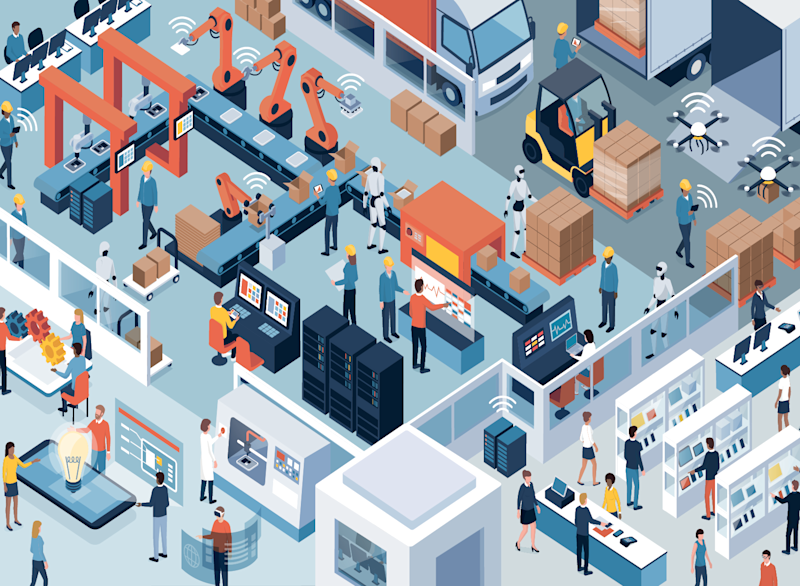The digital twin is often thought of as a nebulous concept that some big company will use in buzzword bingo. Regardless, the underlying technologies to support the concept of a digital twin have matured and are ready for implementation. Companies and industries have identified areas to harvest value from this technology and can reap real-world benefits. In short, the digital twin is a real thing.
The digital twin is the summation of the digital model and the real-world instance. Combining these two creates a digital representation that can be used for various scenarios. The International Organization for Standardization defines the digital twin as “<manufacturing> fit for purpose digital representation of an observable manufacturing element with a means to enable convergence between the element and its digital representation at an appropriate rate of synchronization.” The synchronization in the digital twin’s current state can be seen in three areas: simulation and prediction, as-manufactured, and as-used. Deloitte discusses the various technologies that can converge to allow the twin to be an achievable technology: “Simulation, new sources of data, interoperability, visualization, instrumentation, and platform.” While a 3D model has been around for a long time, it has always been disconnected from the real world. Overlaying the actual conditions of the part is the first step of the digital twin. The next step is harvesting value from this synergy.
Putting the digital twin to work
There are several areas that will benefit from this technology. Within an organization, the areas that will directly benefit from this are product design, process optimization, quality management, supply chain management, predictive maintenance, cross-discipline collaboration, and analyzing the customer experience. According to technology consultant and advisor Daniel Araya, “Going forward, digital twin technology is emerging as one of the key software tools in revolutionizing product development.” Driving change to the furthest point upstream in the value stream will allow for better manufacturing capability and a more robust end product.
The construction industry has begun to accept the value of the digital twin. AIThority discusses the value of the twin in construction: “A digital twin will help project managers visualize how a building works in real-time and helps them to increase performance. For planning and construction of future buildings, data obtained from Digital Twin can be used. The model prediction will monitor the approach and determine, starting with the current building situation, on the basis of forwarding simulation. Managers then can evaluate multiple action paths and measure their possibilities and the resulting cost functions in order to make the right option for the next steps.”
Collaboration
Not only does the twin allow for a deeper understanding of the predicted and real world, but it increases the value of collaboration. According to Deloitte, “Digital twin technology is at the heart of Bridgestone’s transformational journey. The company has used digital twin simulations augmented by sensor data as an R&D tool for several years to improve tire life and performance, but that’s just the beginning. Jerome Boulet, digital strategy director, and Hans Dorfi, director of digital engineering, together with their teams, are developing sophisticated digital twins to eventually deliver insights across Bridgestone’s entire value chain, with the goal of enhancing profitability, sustaining competitive advantage, reducing time-to-market, and delivering leading-edge tire-as-a-service offerings.” Manufacturing has long suffered from design being “thrown over the fence.” Increasing collaboration through systems and processes will drive more efficient processes that will drive the bottom line.
Improving workflows
The twin in manufacturing can be implemented in several areas, including engineering, customization, production, and operations. According to Georg Kube, “Digital twins are now being used to manage the performance, effectiveness, and quality of a manufacturer’s fixed assets such as manufacturing machines, lines, and plants. When advanced visualization, IoT, and analytics are applied to these assets, manufacturers can take a more strategic and holistic approach to asset management.” The twin can be used to provide more context to data from operations. Turning raw data into contextualized information will drive data-driven decision-making across the organization.
Support from management
The key to any new technology is the support from management to drive change within the organization. After that, the underlying technologies to harvest the as-manufactured or as-used conditions are readily available. ArcherGrey discusses the key elements in achieving this technology in an organization: “Senior-level management sponsorship streamlines and bolsters the adoption of the digital twin. With a strong, supported start, your business will be able to reap the benefits of digital twins far faster. … With a comprehensive data and IT strategy, your teams will find it easier to collect and use data to create effective digital twins that help you achieve your business objectives. … Simulations empower your business to validate product enhancements quickly, helping minimize waste in time and material.”
In the end, the digital twin is a concept that that will improve and enhance your products. While this is a constant and continuous stream of data, the end user is harvesting the value of these improvements.






